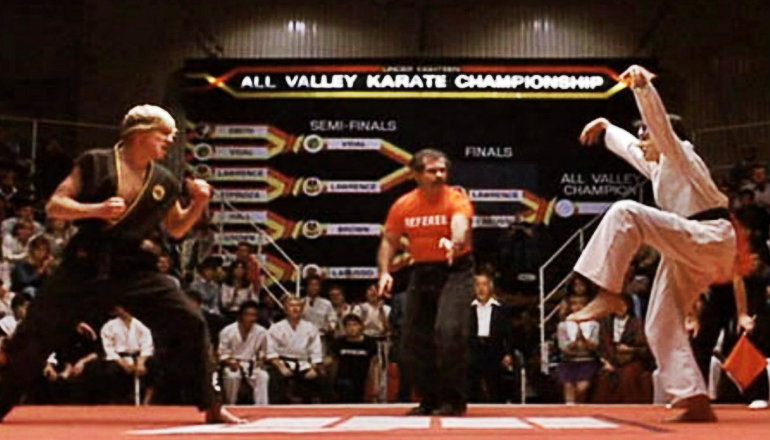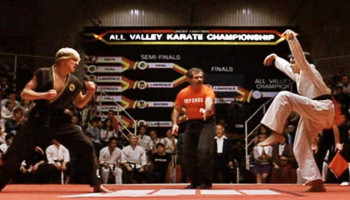 Reading Time: 7 minutes
Reading Time: 7 minutesIn the climactic scene of The Karate Kid, Daniel is losing badly to his rival opponent. Facing defeat, he stands tall on one leg, holds the posture with his arms out wide, and delivers a tournament-winning crane kick — knocking his opponent out in the greatest underdog story ever told.
Now, we all know we cannot be the Karate Kid. But in that moment, right before that fateful blow, Danielson stands on one leg and creates the strength, power, and accuracy to end the match with one kick.
Where did he develop this skill?
Through the teachings of his sensei, Mr. Miyagi, and his endless training on the most fundamental skill in functional movement — balance.
Built with Two, Only Use One
Humans have two legs. Pretty simple, right?
Anatomically, yes, until you start to understand the movement patterns that make us human. The abilities to walk, run, and change direction in an upright, bipedal position are necessary pieces to daily life. When you analyze these movements, you start to realize that the only time you simultaneously use both legs is when you are standing still.
The standing desk you petitioned Human Resources for is an amazing tool. Throughout the day, you are burning more calories, activating your glutes, and keeping your body in an ergonomically safe position.
So why do you still experience back pain?
There is no doubt that standing is better than sitting. Physiologically, however, sitting and standing are just pieces of a larger problem — a movement problem.
The simple act of walking involves a complex system of movement. Your lower body balances on one leg and your upper body braces to create stability and protect the spine. If you lack balance, that instability between your upper and lower body is recognized as a threat to the spine. The brain, as a reaction to a threat, sends a pain signal to your low back to slow you down.
Your low-back pain is a symptom of your lack of balance and your poor movement.
Balance Basics
The act of balancing on one leg necessitates a series of very complex systems. The vestibular, vision, and sensory systems work together to keep you upright and moving in the right direction.
The vestibular system is comprised of three bones located in your inner ear. These three bones are in constant communication with the environment around you. Equilibrium, spatial awareness, and motion are detected by these bones and the brain quickly processes the information so you do not become dizzy every time you rotate your head.
Your vision is another tool that is often misunderstood. Yes, the eye helps you see what is in front of you, but seeing objects is only one piece of the puzzle. Your eyes send signals to the brain about spatial awareness and your orientation to other objects, and this allow your brain to focus on guiding your direction.
The sensory system is in charge of ensuring your feet are on stable ground and that your muscles and joints are communicating with your brain. This is not a simple process. The brain talks to the bottom of the feet to find stability in the ankle, knee, and hip joints. The muscles surrounding these joints — the calves, quads, hamstrings, glutes, and abdominals — all have to activate simultaneously or the brain will sense instability.
In summary, your body has thousands of nerves, muscles, and tendons that play a critical role in movement function. Your ears, eyes, and feet create stability and spatial awareness. Your spine is the super highway that delivers these messages to your brain for processing. When the spine senses instability, the brain recognizes this as a threat, fires the nerves located in the spine, and now you are suffering from chronic back pain.
Balance, it turns out, is a full-body exercise you are performing 10,000 times a day on average.
How to Assess Your Balance
The process of assessment is important for setting baselines and tracking progress. Learning more about specific variables within a system can add depth to your knowledge of how your body operates. Assessing balance is no different.
There are four simple assessments that will take you less than five minutes to complete.
- Level 1: Stand on one leg for 15 seconds. Once complete, repeat on the opposite leg. With this assessment, you are using all three systems — vestibular, vision and sensory — to complete the task.
- Level 2: Repeat level one, but close your eyes. Doing this eliminates the vision input. Take note of how the task becomes more difficult.
- Level 3: Open your eyes, but this time, while standing on one leg, shake your head back and forth. This confuses the vestibular system so you only have vision and sensory systems in play.
- Level 4: Close your eyes and shake your head. This is incredibly challenging and it will be very difficult to make it past 5 seconds.
Assessment is not about whether you passed or failed. Its purpose is to set a baseline that you can retest in the future and have a measure of where you are in the bigger picture of health and movement.
Ideally, you should pass levels one through three. If you cannot, you should add balance training into your daily life.
How to Train Your Balance
There are three main ways to add balance into your training plan. To explain the purpose of these, let’s also look at the three main problems you are likely to have:
Anterior vs. Posterior Deficiencies
Muscular imbalance is a prominent weakness for many suffering from back pain. The body is divided in two halves. The anterior chain (chest, abs, and quads) is balanced by the posterior chain (back, glutes, hamstrings, and calves.) These two halves come together to create stability in your joints.
Sitting all day is a signal for your brain to turn off your posterior chain. Without your posterior chain firing, movements designed for your glutes and abs default to your quads and low back, which leads to chronic pain.
The sumo stance kettlebell deadlift is a tool used to train the squat pattern, alleviate stress on the low back, and activate the posterior chain. Watch the video for details on how to train this movement. You’ll start by learning and practicing some basic squat mechanics.
Left vs. Right Side Dominance
As much as you need balance in your musculature, you also need balance in all planes of movement. Right-handed athletes often develop larger, stronger muscles on their right side creating imbalances and additional stress to their right side. Adding lateral lunges to your training will develop core stability, incorporate the adductors in your legs, and help with moving side-to-side.
Bilateral vs. Unilateral Stability
Remember, when you move, you do it on one leg. So, if there is one movement to master when it comes to dealing with low back pain, it is the single-leg deadlift. This movement demands core stability and anti-rotation, hinging, posterior chain engagement, flexibility, stability, and lower-body pushing and pulling — and tops all that off with a nice dose of grip strength. The single-leg deadlift places the highest demand on the sensory, vestibular, and visual functions of balance through an extended range of motion and full-body muscular recruitment. Master this one and you will never have back pain again.
How to Train These Movements:
- To incorporate these movements into your training, choose an exercise from one of the three categories and practice 15-20 quality reps at some point in your day. Over three training sessions, you will hit all of the movements and be on your way to training pain free.
- If you are rehabbing an injury, add a tempo of five seconds to develop stability throughout the movement. This means, take a full five seconds to execute each repetition of the movement.
- If you are looking to stay healthy and these exercises are more of a maintenance plan for you, then accumulating your reps during a warm up or cool down is more than sufficient.
- For you performance athletes, these movements can be more than just rehab exercises. Adding weight will further challenge your balance, mobility, and stability, and the regular practice of these exercises can have a direct correlation to overall strength.
Learning the basics of balance will not turn you into the Karate Kid. However, when you are practicing your epic crane kick, recognize that balancing on one leg is the most basic form of functional movement. It’s benefits ranging from living pain free to knocking out your fiercest opponents.







